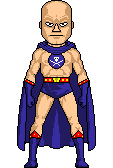First Appearance: Amazing-Man Comics #5 (1939)
Original Publisher: Centaur
Created by: Carl Burgos
Origin:
The Iron Skull was originally a soldier who was gravely injured during World War II (which, in this timeline, was fought partially on American soil well into 1950s). He was brought to Chicago, where Dr. Watson, a surgeon at "Chicago Hospital," worked to replace his flesh and bones with metalic components. The resulting cyborg was super-strong, resistant to bullets and capable of limited telepathy. His new face was missing a nose, giving him a skull-like appearance.
By the year 1960, the Second World War wound down and reconstruction began. This year also saw a rise of rampant crime that the police struggled to contain. The cyborg decided to use his abilities to fight crime in Chicago as the Iron Skull.
In Amazing Comics #9, the story jumped forward to 1970, when America was once again threatened with war. The spies working for an unnamed country "spread terror throughout United States," forcing the Iron Skull to intercede. Two issues later, in 1971, war broke out in Europe and spy activities intensified.
In Amazing Comics #14, the Iron Skull set up operations in New York City. The next issue, he developed a mental link with D.A. of New York. The D.A. used that ability to alert the Iron Skull of any crime in progress.
Stars and Stripes #3, saw Iron Skull wearing a costume for the first time (a pair of trunks). The next issue, he inexplicably lost his hair and gained an ability to fly (not to mention a skull-and-crossbones logo on his chest).
Iron Skull wore a ring that he would use to stamp a skull and crossbones symbol on the foreheads of his vanquished foes.
Public Domain Appearances:
Amazing Man Comics #5-11, 14-20, 22
Stars and Stripes Comics #2-6
Notes:
The first two appearances of Iron Skull did not give any dates, nor did they reveal Iron Skull's origin. The story in Amazing Man Comics #7 revealed his origin and explained that his adventures were set in the future. The subsequent issues moved the story forward until Amazing Comics #14, when all references to future dates were dropped, and the technology got noticeably less futuristic (though a few pieces of advanced technology still occasionally showed up). Later stories included topical references to American military build-up and "the Fuhrer." This shift in setting may be due to the fact Issue 14 was when artist-writer Sam Gilman replaced the feature creator Carl Burges. Gilman either didn't know the story was supposed to be set in the past or didn't care.


No comments:
Post a Comment
DIRECT CURRENT